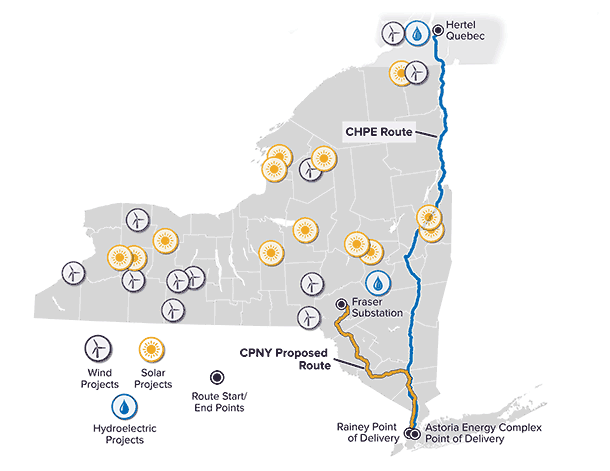Tier 4 – New York City Renewable Energy


New York is transforming its electricity sector to be powered by renewable energy. By 2030, 70 percent of the State’s electricity will come from renewable sources putting New York on path to a 100 percent zero-emission grid by 2040 as mandated by the Climate Leadership and Community Protection Act (Climate Act) ![]() .
.
Today, while renewable energy is abundant in upstate New York, bottlenecks inhibit that energy from moving downstate, to the nation’s largest load center, New York City. Upstate New York’s power mix is approaching 90 percent emission‐free – whereas New York City’s power is almost 90 percent fossil fuel‐based.
New York City, representing nearly one-third of New York State’s annual electric demand, is isolated from accessing the abundant renewable energy to its north by existing constraints in the electric grid.
NYSERDA’s Tier 4 Program was created by order of the New York State Public Service Commission in 2020 to increase the penetration of renewable energy into New York City (NYISO Zone J) and help address its dependency on polluting fossil fuel-fired generation.
Clean Energy Infrastructure: The Tier 4 Projects
After a competitive solicitation, two transformational renewable energy and transmission projects - Clean Path New York and the Champlain Hudson Power Express - were awarded Tier 4 contracts. Combined, these projects are expected to deliver 18 million megawatt-hours of clean energy per year to New York City, or more than a third of the City’s annual consumption. During their construction and operation, the projects are expected to generate close to $6 billion in overall net societal benefits statewide, inclusive of greenhouse gas reductions and air quality improvements, and over $8 billion in economic development, including investments in disadvantaged communities.
As the largest transmission projects in New York State in the last 50 years, these projects will reduce New York City’s fossil fuel electricity by more than 80 percent in 2030 when combined with the State’s deployment of clean energy and offshore wind. These projects accelerate progress toward New York's goal of 70 percent of the State's electricity from renewable sources by 2030, and a zero-emissions grid by 2040, as outlined in the Climate Leadership and Community Protection Act (Climate Act).


Fact Sheet
To learn more about these projects, view the Tier 4 Fact Sheet [PDF]

